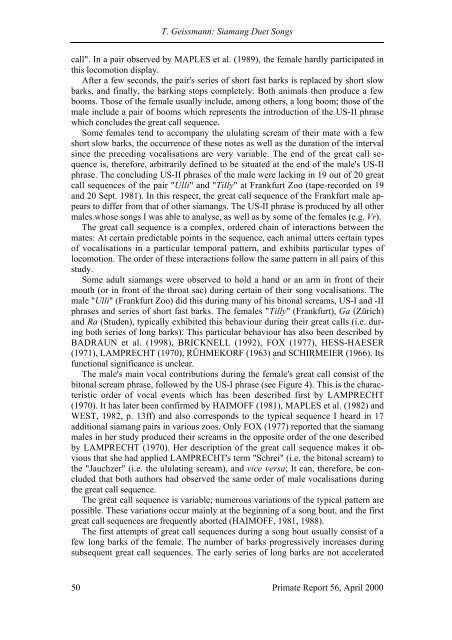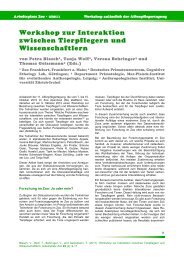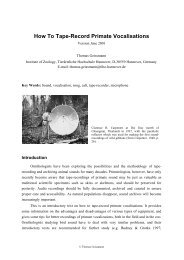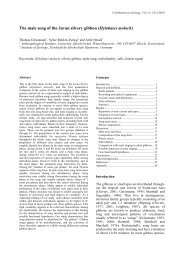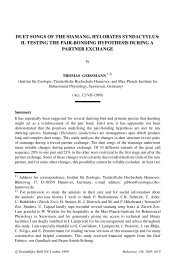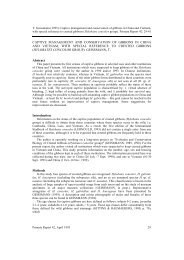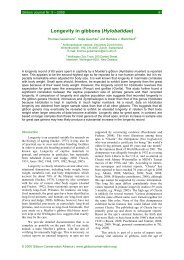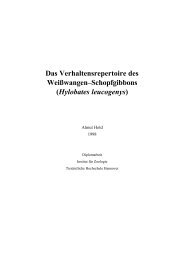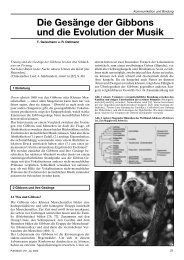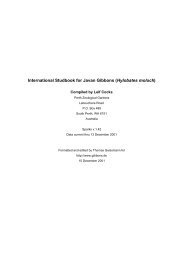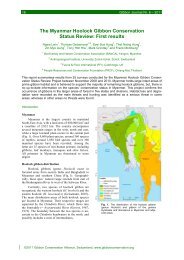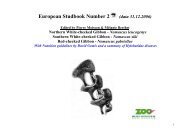Geissmann, T., 2000: Duet songs of the siamang, Hylobates ...
Geissmann, T., 2000: Duet songs of the siamang, Hylobates ...
Geissmann, T., 2000: Duet songs of the siamang, Hylobates ...
You also want an ePaper? Increase the reach of your titles
YUMPU automatically turns print PDFs into web optimized ePapers that Google loves.
T. <strong>Geissmann</strong>: Siamang <strong>Duet</strong> Songs<br />
call". In a pair observed by MAPLES et al. (1989), <strong>the</strong> female hardly participated in<br />
this locomotion display.<br />
After a few seconds, <strong>the</strong> pair's series <strong>of</strong> short fast barks is replaced by short slow<br />
barks, and finally, <strong>the</strong> barking stops completely. Both animals <strong>the</strong>n produce a few<br />
booms. Those <strong>of</strong> <strong>the</strong> female usually include, among o<strong>the</strong>rs, a long boom; those <strong>of</strong> <strong>the</strong><br />
male include a pair <strong>of</strong> booms which represents <strong>the</strong> introduction <strong>of</strong> <strong>the</strong> US-II phrase<br />
which concludes <strong>the</strong> great call sequence.<br />
Some females tend to accompany <strong>the</strong> ululating scream <strong>of</strong> <strong>the</strong>ir mate with a few<br />
short slow barks, <strong>the</strong> occurrence <strong>of</strong> <strong>the</strong>se notes as well as <strong>the</strong> duration <strong>of</strong> <strong>the</strong> interval<br />
since <strong>the</strong> preceding vocalisations are very variable. The end <strong>of</strong> <strong>the</strong> great call sequence<br />
is, <strong>the</strong>refore, arbitrarily defined to be situated at <strong>the</strong> end <strong>of</strong> <strong>the</strong> male's US-II<br />
phrase. The concluding US-II phrases <strong>of</strong> <strong>the</strong> male were lacking in 19 out <strong>of</strong> 20 great<br />
call sequences <strong>of</strong> <strong>the</strong> pair "Ulli" and "Tilly" at Frankfurt Zoo (tape-recorded on 19<br />
and 20 Sept. 1981). In this respect, <strong>the</strong> great call sequence <strong>of</strong> <strong>the</strong> Frankfurt male appears<br />
to differ from that <strong>of</strong> o<strong>the</strong>r <strong>siamang</strong>s. The US-II phrase is produced by all o<strong>the</strong>r<br />
males whose <strong>songs</strong> I was able to analyse, as well as by some <strong>of</strong> <strong>the</strong> females (e.g. Vr).<br />
The great call sequence is a complex, ordered chain <strong>of</strong> interactions between <strong>the</strong><br />
mates: At certain predictable points in <strong>the</strong> sequence, each animal utters certain types<br />
<strong>of</strong> vocalisations in a particular temporal pattern, and exhibits particular types <strong>of</strong><br />
locomotion. The order <strong>of</strong> <strong>the</strong>se interactions follow <strong>the</strong> same pattern in all pairs <strong>of</strong> this<br />
study.<br />
Some adult <strong>siamang</strong>s were observed to hold a hand or an arm in front <strong>of</strong> <strong>the</strong>ir<br />
mouth (or in front <strong>of</strong> <strong>the</strong> throat sac) during certain <strong>of</strong> <strong>the</strong>ir song vocalisations. The<br />
male "Ulli" (Frankfurt Zoo) did this during many <strong>of</strong> his bitonal screams, US-I and -II<br />
phrases and series <strong>of</strong> short fast barks. The females "Tilly" (Frankfurt), Ga (Zürich)<br />
and Ra (Studen), typically exhibited this behaviour during <strong>the</strong>ir great calls (i.e. during<br />
both series <strong>of</strong> long barks). This particular behaviour has also been described by<br />
BADRAUN et al. (1998), BRICKNELL (1992), FOX (1977), HESS-HAESER<br />
(1971), LAMPRECHT (1970), RÜHMEKORF (1963) and SCHIRMEIER (1966). Its<br />
functional significance is unclear.<br />
The male's main vocal contributions during <strong>the</strong> female's great call consist <strong>of</strong> <strong>the</strong><br />
bitonal scream phrase, followed by <strong>the</strong> US-I phrase (see Figure 4). This is <strong>the</strong> characteristic<br />
order <strong>of</strong> vocal events which has been described first by LAMPRECHT<br />
(1970). It has later been confirmed by HAIMOFF (1981), MAPLES et al. (1982) and<br />
WEST, 1982, p. 13ff) and also corresponds to <strong>the</strong> typical sequence I heard in 17<br />
additional <strong>siamang</strong> pairs in various zoos. Only FOX (1977) reported that <strong>the</strong> <strong>siamang</strong><br />
males in her study produced <strong>the</strong>ir screams in <strong>the</strong> opposite order <strong>of</strong> <strong>the</strong> one described<br />
by LAMPRECHT (1970). Her description <strong>of</strong> <strong>the</strong> great call sequence makes it obvious<br />
that she had applied LAMPRECHT's term "Schrei" (i.e. <strong>the</strong> bitonal scream) to<br />
<strong>the</strong> "Jauchzer" (i.e. <strong>the</strong> ululating scream), and vice versa; It can, <strong>the</strong>refore, be concluded<br />
that both authors had observed <strong>the</strong> same order <strong>of</strong> male vocalisations during<br />
<strong>the</strong> great call sequence.<br />
The great call sequence is variable; numerous variations <strong>of</strong> <strong>the</strong> typical pattern are<br />
possible. These variations occur mainly at <strong>the</strong> beginning <strong>of</strong> a song bout, and <strong>the</strong> first<br />
great call sequences are frequently aborted (HAIMOFF, 1981, 1988).<br />
The first attempts <strong>of</strong> great call sequences during a song bout usually consist <strong>of</strong> a<br />
few long barks <strong>of</strong> <strong>the</strong> female. The number <strong>of</strong> barks progressively increases during<br />
subsequent great call sequences. The early series <strong>of</strong> long barks are not accelerated<br />
50 Primate Report 56, April <strong>2000</strong>


